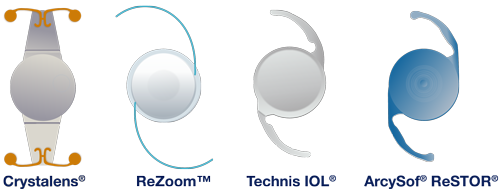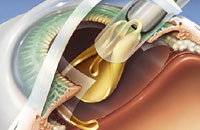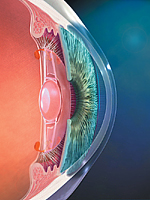As we age, the natural lens inside the eye begins to harden and lose flexibility. This reduces the eyes ability to change focus from far away to intermediate to up close. This is known as presbyopia and it typically occurs near age 40.
Early symptoms may include difficulty seeing things up close. You may start to become dependent on bifocal glasses, which allow you to see clearly at all distances.
However, if you’d rather not be dependent on glasses, you might consider another option: implantable lenses. They can help correct presbyopia and may lessen or eliminate your need for bifocal glasses.
Types of bifocal implants
There are several options to consider for bifocal implants, each of which has its own unique benefits.

ReZOOM
 The ReZOOM multifocal IOL is designed to give patients a better range of vision after surgery. The ReZOOM technology distributes light over five different optic zones so that each lens has a distance-dominate central zone for vision in bright light. With five separate visual zones designed to work with varying light conditions, ReZOOM gives people the ability to see at far, near, and intermediate distances. If you have trouble reading and need bifocals, or if your vision is becoming increasingly blurred, ReZOOM multifocal lens may be able to help.
The ReZOOM multifocal IOL is designed to give patients a better range of vision after surgery. The ReZOOM technology distributes light over five different optic zones so that each lens has a distance-dominate central zone for vision in bright light. With five separate visual zones designed to work with varying light conditions, ReZOOM gives people the ability to see at far, near, and intermediate distances. If you have trouble reading and need bifocals, or if your vision is becoming increasingly blurred, ReZOOM multifocal lens may be able to help.
ReSTOR
The ReSTOR lens is an artificial lens that replaces the natural lens of the eye. It is made of a soft, flexible material that allows the lens to focus light on the retina for clear vision at near, far, and intermediate distances. This lens can greatly affect the quality of vision providing clear, sharp images at all distances. It can also increase the quantity of vision by allowing you to see at all distances.
ReSTOR is a lens that will help to correct presbyopia and eliminate cataracts (the clouding of the eye’s natural lens). The ideal candidate for ReSTOR lenses is someone who is seeking better vision at all distances and wants to reduce or possibly eliminate their dependence on glasses.
Tecnis
The Tecnis multifocal lens is designed to give patients the ability to see at any distance and at any level of light, including lower light. While Tecnis provides the same vision correction after cataract surgery for presbyopia as other premium lens implants, it also gives you this vision correction at all light levels, which is something not all premium lens implants can provide.
If you have been diagnosed with cataracts and have difficulty reading, seeing objects up close, and driving at night, you might find that the Tecnis multifocal lens is the best option.
Crystalens
 Crystalens is an accommodating intraocular lens (IOL) designed to replace the eye’s natural lens. It is beneficial for people who want to be able to see without their glasses after cataract surgery or for those who want better vision with a clear lens exchange.
Crystalens is an accommodating intraocular lens (IOL) designed to replace the eye’s natural lens. It is beneficial for people who want to be able to see without their glasses after cataract surgery or for those who want better vision with a clear lens exchange.
The Crystalens IOL is designed to work on a hinge, which allows the optic, or the part of the IOL that you see through, to move back and forth as your eye constricts and relaxes, just like a natural lens. This provides a continuous range of vision at far, intermediate and near distances.
Toric Lens Implants
Dr. Benaim also offers Acrysof Toric Aspheric and Staar Toric IOLs. Please visit Toric Lens Implants to learn more.
Not sure which bifocal implant to choose? Dr. Benaim can help you find the best option to correct presbyopia and suite your individual needs.
To schedule an appointment, call 561-747-7777.
 New Address:
New Address: